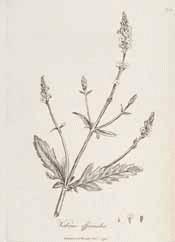
Botanical.com Home Page

|
Vervain
(Verbena setosa printed as
Verbena officinalis)
Click on graphic for larger image
|
Vervain
Botanial: Verbena officinalis (LINN.), Verbena hastata
Family: N.O. Verbenaceae
---Synonyms---Herb of Grace. Herbe Sacrée. Herba veneris.
---Parts Used---Leaves, flowering heads.
---Habitat---Europe, Barbary, China, Cochin-China, Japan.
---Description---In England the Common Vervain is found growing by roadsides and in sunny pastures. It is a perennial bearing many small, pale-lilac flowers. The leaves are opposite, and cut into toothed lobes. The plant has no perfume, and is slightly bitter and astringent in taste. The name Vervain is derived from the Celtic ferfaen, from fer (to drive away) and faen (a stone), as the plant was much used for affections of the bladder, especially calculus. Another derivation is given by some authors from Herba veneris, because of the aphrodisiac qualities attributed to it by the Ancients. Priests used it for sacrifices, and hence the name Herba Sacra. The name Verbena was the classical Roman name for 'altar-plants' in general, and for this species in particular. The druids included it in their lustral water, and magicians and sorcerers employed it largely. It was used in various rites and incantations, and by ambassadors in making leagues. Bruised, it was worn round the neck as a charm against headaches, and also against snake and other venomous bites as well as for general good luck. It was thought to be good for the sight. Its virtues in all these directions may be due to the legend of its discovery on the Mount of Calvary, where it staunched the wounds of the crucified Saviour. Hence, it is crossed and blessed with a commemorative verse when it is gathered. It must be picked before flowering, and dried promptly.
[Top]
---Constituents---The plant appears to contain a peculiar tannin, but it has not yet been properly analysed.
---Medicinal Action and Uses---It is recommended in upwards of thirty complaints, being astringent, diaphoretic, antispasmodic, etc. It is said to be useful in intermittent fevers, ulcers, ophthalmia, pleurisy, etc., and to be a good galactogogue. It is still used as a febrifuge in autumn fevers.
As a poultice it is good in headache, earneuralgia, rheumatism, etc. In this form it colours the skin a fine red, giving rise to the idea that it had the power of drawing the blood outside. A decoction of 2 OZ. to a quart, taken in the course of one day, is said to be a good medicine in purgings, easing pain in the bowels. It is often applied externally for piles. It is used in homoeopathy.
Fluid extract, 1/2 to 1 drachm.
---Other Species---
Verbena Jamaicensis (JAMAICA VERVAIN) grows in Jamaica, Barbados, and other West Indian islands, bearing violet flowers. The juice is used in dropsy and for children as an anthelmintic and cooling cathartic. The negroes use it as an emmenagogue, and for sore and inflamed eyes. As a poultice, with wheat-flour, the bruised leaves are used for swelling of the spleen, and for hard tumours at their commencement.
V. Lappulaceae (BURRY VERVAIN), another West Indian herb, with pale blue flowers, is a vulnerary sub-astringent, being used even for very severe bleeding wounds in men and cattle, especially in Jamaica.
V. hastata (BLUE VERVAIN, Wild Hyssop, Simpler's Joy) is indigenous to the United States, and is used unofficially as a tonic emetic, expectorant, etc., for scrofula, gravel, and worms. A fluid extract is prepared from the dried, over-ground portion.
V. Urticifolia. The root, boiled in milk and water with the inner bark of Quercus Alba, is said to be an antidote to poisoning by Rhus Toxicodendron.
V. Sinuata. An infusion of the root, taken as freely as possible, is said to be a valuable antisyphilitic.
Common Name Index
A MODERN HERBAL Home Page
Bear in mind "A Modern Herbal" was written with the conventional wisdom of the early 1900's. This should be taken into account as some of the information may now be considered inaccurate, or not in accordance with modern medicine.
© Copyright Protected 1995-2024 Botanical.com
|

